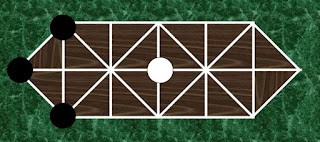This one only requires minimal supplies, plays very fast, and has very straightforward rules.
It is quick and easy to explain to newcomers, and yet can become very competitive and subtle in terms of available strategies.
 |
| A typical Hare & Hounds board : A couple squares and 4 tokens are all it takes. |
It's one of those perfect games to play on holidays or in case of bad weather, without the need for crazy setups.
A game could be improvised from items laying around in most environments (at school, while camping, at the bar, on the beach...)
Read along if you want to give it a shot. It will be quick I promise!
The game (you just lost it)
The Hare and Houds game comes in many names and variations and has most likely been played since the middle ages.The corresponding wikipedia page will list it's variants better than I could.
Whatever the name or theme, all those games share a common structure:
- A small playing board made of highly interconnected spots.
- One players plays the side that has a numeric advantage
- One players plays an unique token, that compensates being outnumbered with a slight movement advantage.
- The player having multiple tokens must entrap the adversary, while the player having only one token must "escape" by passing behind the ennemy lines to win.
The rules
So here is exactly what is going on:- The game is played on a grid similar to this one, where all intersections are valid positions.
- One player plays the hounds, and starts with 3 tokens placed on one side of the board.The other one plays the hare and starts at the opposite side. There is no commonly agreed-upon first-player rule, so you can determine that as you like it.
- Players take turns to move one token.
- A hound token can move to any adjacent spot, in front, diagonally, or the sides of it.( basically, any spot that is linked by a line to it's current position, but with no going back allowed). Only one token can be moved at each turn.
- The hare moves in a similar fashion, but is also allowed to go back.
- Only one piece is allowed on each spot at any given time.
- There is no "catching" pieces as in chess or other boardgames.
- The hounds win if they manage to trap the hare in a single spot, and he cannot move anywhere.
- The hare wins if he manages to get "beyond" the last hound or to a position where he cannot be trapped any more.
Doesn't seem like much right? Especially on such a small board.
But the actual strategic possibilities are really wide, and will keep you busy for some time trying tp master the game!
And don't worry.The game is fair for both sides, no matter who plays first :)
Try it out now!
Being that simple and well known, the game has been wildly implemented on various supports.You can try it right now in your browser here.
You also won't have any trouble finding numerous mobile variants for your phone or tablet.
Give the link above a shot for a quick taste of the gameplay, winning conditions, and how the game involves much more strategy than it appears at first glance!
Once you've played as one side and got your ass kicked by the IA enough times to think that the other side has an unfair advantage: switch sides, and get your ass kicked some more :p.
Variations
Boards and rules
There have been many variations of the game, so here are some in case you need some more challenge: |
| Longer game board |
 | ||||||
| Exact same rules applied on a checkerboard make it the "fox and geese" game. |
 | ||
| Slightly different rules including catching mechanics apply to this more massive variant called "catch the hare" (play it online). |
Improvised materials:
Simplicity of the game and game board lends itself very well to improvised games.Some items you could use for improvised games include:
- Drawn board, using coins as tokens
- Board scribed in the dirt, using stones or pine cones as tokens
- Board drawn in the sand, again, using stones or shells as tokens.
- If you're stuck at school, a drawn or scratched board will probably blend well with all the other tags most likely already present on your table.And pen caps or pieces of torn paper will do perfect and inconspicuous game tokens.
- Aboard a plane or in a car: a flyer or other kind of thick paper could be used as a board by folding it into the classic origami "salt cellar" and unfolding two opposing corners to get a perfect representation of the game board. Torn pieces from the leftovers from squaring the piece of paper will act as the tokens.
 |
| Follow steps 1-4, and unfold two opposing corners.Bingo ! an improvised Hare and Hounds board without even needing a pen. |
Themes
Of course the "hoard vs one" theme lends itself to many variations on the topic of the game itself.Hounds and hares were often replaced by dwarves and goblins, cops and thieves, army vs spy, or survivors vs zombies.
Ok, I'll admit this last chapter is only an excuse to share a cute zombie themed variation of the game I stumbled upon at thingiverse. If you own a 3D printer, or know somebody who does, give this variation a shot !




No comments:
Post a Comment